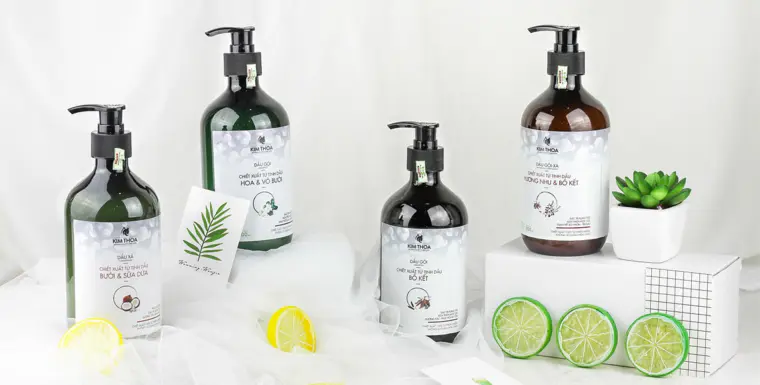As someone who has gone through the trials and tribulations of hair damage from coloring and heat styling, I can empathize with the frustration of trying to restore your hair’s health. Thankfully, I’ve discovered numerous natural methods to repair damaged and color-treated hair that have worked wonders for me, and I’m eager to share these solutions with you.

Quick Links
Recognizing Hair Damage and Its Causes
Identifying the signs of hair damage is the first step towards restoring hair health. It’s important to understand the typical manifestations of hair damage and their causes. These symptoms can range from split ends and dryness to breakage, thinning, or even a combination of these issues, depending on the severity and type of damage.
One common cause of hair damage is the use of heat styling tools, such as flat irons, curling irons, and hair dryers. These tools can weaken hair fibers, leading to breakage and split ends. Another significant source of hair damage is chemical processing. Bleaching, perming, or coloring hair can strip it of its natural oils, leaving it vulnerable to further damage. Even exposure to harsh environmental conditions such as excessive sun, wind, or cold can also compromise your hair’s health.
While these issues may seem daunting, the question “how can I repair my damaged hair?” has several answers. One highly effective solution that I’ve discovered through personal experience is the use of natural oils, specifically coconut oil and argan oil. These oils are rich in essential nutrients and fatty acids that can replenish the hair’s moisture, protect it from damage, and enhance its overall health and shine.
For me, Arvazallia Argan Hair Oil has been a lifesaver. This premium product is chock-full of nourishing properties that have worked wonders on my hair. It helps restore shine, reduces frizz, and strengthens hair strands. Over time, with consistent use, you’ll notice a significant improvement in your hair’s texture and manageability. It is indeed a fantastic option if you’re looking to repair your damaged hair at home, as it saves you the time and cost of salon treatments while offering similar, if not superior, results.
The Art of Nourishing Color-Treated Hair

Color-treated hair requires special care to maintain its vibrancy and health. When we color our hair, it undergoes a chemical process that can strip it of its natural moisture, leaving it vulnerable to damage. If wondering how you can repair damaged, color-treated hair, the answer lies in providing it with the nourishment and protection it needs.
For starters, it’s essential to use a color-safe shampoo that will not strip the color from your hair. These types of shampoos are formulated to cleanse your hair gently while maintaining the vibrancy of your color. Incorporating a deep conditioning treatment once a week is also a game-changer. This regimen provides a hefty dose of hydration and nourishment that our hair craves, helping to combat dryness and breakage.
But that’s not all – did you know that you can utilize the power of nature to care for your colored hair? Certain natural ingredients, like chamomile, black tea, and beetroot, can help enhance and maintain the richness of your hair color. Chamomile is known to add golden highlights to blonde hair, black tea can deepen brunette hues, and beetroot provides a fantastic color boost for redheads. These ingredients not only help enhance color but also add a natural shine to your hair.
Remember, a little extra care can go a long way in maintaining the beauty of color-treated hair. So while the journey to restore damaged, color-treated hair might seem like a long one, patience, persistence, and the right products can help you get there!
The Importance of a Natural Hair Care Regimen
Struggling with how to fix damaged hair naturally? Don’t worry, I’ve been there, and I can tell you that it’s entirely possible to restore your hair’s health using natural methods! When you switch to a more natural hair care routine, you’re giving your hair the best possible opportunity to recover and flourish.
Gentle Cleansing
One significant change I made was switching to a sulfate-free, gentle shampoo. Sulfates are harsh chemicals found in many conventional shampoos that can strip your hair of its natural oils, causing it to become dry and brittle. By choosing a sulfate-free shampoo, I could clean my hair without stripping it of its essential oils, which are crucial for maintaining healthy locks.
Deep Conditioning Treatment
Along with a gentle shampoo, another cornerstone of my hair care routine is a weekly deep conditioning treatment. This routine provides an extra layer of hydration and nourishment that my hair needs to bounce back from any damage. Deep conditioners, especially those with natural ingredients such as shea butter, avocado, and honey, work wonders in replenishing the hair’s moisture levels and improving its overall health and shine.
Adding a leave-in conditioner to my routine was another game-changer. Leave-in conditioners offer a fantastic way to detangle and moisturize your hair, preventing breakage caused by rough handling. They also add a layer of protection that can shield your hair from environmental stressors throughout the day.
Air Drying for Hair Recovery
Lastly, I made the switch from heat styling to air drying my hair. Constant heat styling can take a serious toll on your hair, causing it to become weak and damaged over time. By air-drying my hair, I allow it to rest and recover from any damage naturally, giving it a chance to regain its strength.
It’s all about creating a routine that caters to your hair’s specific needs, one that promotes healing and health. So if you’re on a mission to fix your damaged hair, a switch to a natural hair care routine could be just the ticket. Believe me, your hair will thank you for the TLC!
A Kitchen Full of Remedies: Homemade Hair Masks
Are you – like many of my clients – asking, “how can I repair my damaged hair at home?” Look no further than your kitchen. Homemade hair masks are highly effective in repairing and nourishing your hair. Using ingredients likely already available to you, you can concoct masks that rival expensive salon treatments!
Let’s explore three of my favorite homemade remedies.
Avocado and Honey Hair Mask: Avocados are packed with vitamins B and E, protecting and strengthening hair at the cellular level. Honey, a natural humectant, locks in moisture. To prepare this mask:
- Mash one ripe avocado until smooth.
- Mix in two tablespoons of honey.
- Apply to damp hair, especially focusing on the ends.
- Leave it on for about 30 minutes before rinsing.
Coconut Oil and Egg Mask: Particularly good for dry or brittle hair, coconut oil nourishes the hair shaft from within, while eggs provide protein for strengthening. Here’s how you make it:
- Mix together two tablespoons of melted coconut oil with one egg.
- Apply to damp hair.
- Let it sit for 15-20 minutes.
- Rinse thoroughly.
Banana and Olive Oil Mask: Bananas contain silica, a mineral that helps synthesize collagen, potentially making hair stronger and thicker. Olive oil moisturizes hair and reduces scalp irritation. To make this mask:
- Blend one ripe banana with two tablespoons of olive oil until smooth.
- Apply the mixture to your hair, focusing on damaged areas.
- Let it sit for 20-30 minutes.
- Rinse thoroughly.
These DIY hair masks are a natural, cost-effective way to treat damaged hair. So, the next time you’re wondering how to repair your bleached, damaged hair, reach for these ingredients in your pantry!
Effective Strategies for Healthy, Radiant Hair
Wading through the sea of damaged and color-treated hair solutions might be daunting, but remember, nature offers an abundance of resources to restore your hair’s health and radiance. Here’s how to implement a holistic hair repair regimen that promotes not just hair health, but also overall wellbeing.
By choosing to utilize nature’s offerings, you’re effectively nourishing and fortifying your hair, avoiding the potential harm of harsh chemicals and treatments. This shift to a more conscious, gentle approach is key when considering how to repair damaged hair. A study published in the Journal of Cosmetic Dermatology suggests that using natural oils can significantly reduce hair damage, support growth, and enhance hair shine and smoothness.
Incorporate these practices for a more natural hair care regimen:
- Heat Styling Moderation: While it might be tempting to reach for the hairdryer or flat iron, excessive heat styling can wreak havoc on your hair health, leading to brittleness, dryness, and split ends. Air drying is the gentlest way to dry your hair, retaining its natural moisture and reducing the risk of heat-induced damage. If using heat styling tools is unavoidable, consider using a lower temperature setting and a heat protectant.
- Mindful Washing: Overwashing your hair can strip it of its natural oils, leading to dryness and scalp irritation. Try to limit shampooing to 2-3 times a week. Consider a gentle, sulfate-free shampoo which can cleanse your hair without stripping it of its natural oils.
- Nourish from Within: Good hair health starts from within. Consuming a balanced diet rich in vitamins and minerals can greatly improve the health and texture of your hair. Nutrients like vitamin A, B-vitamins, vitamin C, vitamin D, iron, and zinc play essential roles in hair growth and health.
As I often tell my clients, in making these small adjustments to your hair care routine, you’re not just addressing your hair damage, you’re also contributing to your overall wellbeing. Robust, radiant hair is an achievable goal, and one that doesn’t require you to compromise your health or your budget. Embrace these natural solutions and watch your hair transform!





